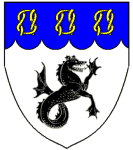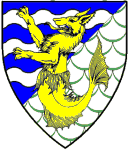| View previous topic :: View next topic |
| Author |
Message |
Sea Wolf
Joined: 01 Nov 2003
Posts: 8650
City/Region: Redding
State or Province: CA
C-Dory Year: 1987
C-Dory Model: 22 Cruiser
Vessel Name: Sea Wolf
Photos: Sea Wolf
|
 Posted: Thu Oct 27, 2011 4:27 pm Post subject: Posted: Thu Oct 27, 2011 4:27 pm Post subject: |
 |
|
Getting the final sized holes to line up will be the hardest part!
I'd go ahead and,
1) on the work bench, put the roller together with the pivot pin (bolt), then
2) using the most accurate method I could devise, find a position for the locking pin exactly symmetrically located on opposite sides of the complete assembly for the locking pin, then
3) center punch these two positions, and drill small pilot holes through both the first and second layers of stainless steel metal. Use oil, slow speeds, a sharp drill bit, and rely on pressure to make the sharp bit cut, rather than burning it up with high drill speed rpm.
( The next steps would probably be easier to done with the assembly mounted on the boat for stability, for safety, for a secure drilling position, and for ease of applying pressure, providing there is room for the drill to operate. If not, the roller can be mounted to a large board held in a vice. The bits must be kept perpendicular to the side surface of the anchor roller to allow the final holes to line up!)
5) check the holes for symmetrical location, then start to enlarge them with progressively slightly larger diameter bits. Smaller steps is easier and safer, too!
5) when you approach the locking pin diameter, get a drill bit slightly undersized and long enough to span across the entire width of the assembly. Drill each side out, then drill across the entire assembly from both sides. This will assure you that the holes will line up for the pin.
6) repeat step 5 with a full sized drill bit equivalent to the locking pin diameter.
7) put the pin in the holes and see what you've got! It should fit tight!
 clean up the holes by taking the assembly apart and using a countersink to clean off the burs, but without changing the diameter of the overall holes. You may have to use the countersink with your fingers on the insides of the holes where the drill won't fit. clean up the holes by taking the assembly apart and using a countersink to clean off the burs, but without changing the diameter of the overall holes. You may have to use the countersink with your fingers on the insides of the holes where the drill won't fit.
9) I like to use a push-button ball-lock pin in this type of application , and secure the pink with a stainless wire or nylon cord to something close by so it cannot be lost overboard. You can also use a standard clevis pin with a hole provided in the one end and a ring-ding to secure it in position.
I may elaborate later, but have to go for now! (Cants get the substituted emoticon for  to appear right!) to appear right!)
Joe.  
_________________
Sea Wolf, C-Brat #31
Lake Shasta, California
  
"Most of my money I spent on boats and women. The rest I squandered'. " -Annonymous |
|
| Back to top |
|
 |
ferret30
Joined: 22 Mar 2011
Posts: 569
City/Region: Seattle
State or Province: WA
C-Dory Year: 2006
C-Dory Model: 22 Cruiser
Vessel Name: Lily Pad
Photos: Lily Pad
|
 Posted: Thu Oct 27, 2011 9:40 pm Post subject: Posted: Thu Oct 27, 2011 9:40 pm Post subject: |
 |
|
Hey Joe, excellent instructions. I think the most important mistake I could still make now is to forget to leave room for the heads of the deck mounting bolts and line up the holes with the roller tilted all the way up! I will try not to do that!
I'm looking for something to order to use as the pin. I looked on several websites for different combinations of terms (ball release pin etc.) and found things that look close to what I'm imagining, but none of them are 4" long which is what it would take to go entirely through the roller pieces. Most are like 2", or aren't stainless, etc.
Any leads/links to a place where I can buy a suitable pin? I'd like to get one *before* I start drilling holes so I don't drill the wrong size!
Edit: I just found them. The term is "Detent Ring Pin" and the "grip" specification is the length between the ring hole and the ball. Looks like something like this will work:
http://www.amazon.com/Aerofast-Inc-FPSC5-40R-Ring-Handle-Diameter/dp/B002GPLCXQ/ref=sr_1_1?ie=UTF8&qid=1319766293&sr=8-1 |
|
| Back to top |
|
 |
thataway
Joined: 02 Nov 2003
Posts: 21378
City/Region: Pensacola
State or Province: FL
C-Dory Year: 2007
C-Dory Model: 25 Cruiser
Vessel Name: thataway
Photos: Thataway
|
 Posted: Thu Oct 27, 2011 9:55 pm Post subject: Posted: Thu Oct 27, 2011 9:55 pm Post subject: |
 |
|
The AeroFast pins will work well. I own a drill press just for work like this--and carried it aboard all of my voyages in larger boats. (A C Dory does not lend to a stand up work shop in the engine room however!). I used a simple center punch, and a cutting oil--going very slowly, and keeping steady pressure.
For many of the bow anchors I use flat head screws, with an aluminum backing plate below the deck. The plate in the bottom of the roller is counter sunk, so that there are no screw heads or bolt heads pround of the surface of the bottom piece of the assembly.
_________________
Bob Austin
Thataway
Thataway (Ex Seaweed) 2007 25 C Dory May 2018 to Oct. 2021
Thisaway 2006 22' CDory November 2011 to May 2018
Caracal 18 140 Suzuki 2007 to present
Thataway TomCat 255 150 Suzukis June 2006 thru August 2011
C Pelican; 1992, 22 Cruiser, 2002 thru 2006
Frequent Sea; 2003 C D 25, 2007 thru 2009
KA6PKB
Home port: Pensacola FL |
|
| Back to top |
|
 |
ferret30
Joined: 22 Mar 2011
Posts: 569
City/Region: Seattle
State or Province: WA
C-Dory Year: 2006
C-Dory Model: 22 Cruiser
Vessel Name: Lily Pad
Photos: Lily Pad
|
 Posted: Thu Oct 27, 2011 10:16 pm Post subject: Posted: Thu Oct 27, 2011 10:16 pm Post subject: |
 |
|
| thataway wrote: | | The plate in the bottom of the roller is counter sunk, so that there are no screw heads or bolt heads pround of the surface of the bottom piece of the assembly. |
This one is a used "Simpson Lawrence" that I got on ebay for $55. It doesn't have countersunk mounting holes, just plain 3/8" holes. It's in much better shape and a lot sturdier than the one I took off the boat!
I think I'll get the 3/8" dia. by 4" grip pin. |
|
| Back to top |
|
 |
Sea Wolf
Joined: 01 Nov 2003
Posts: 8650
City/Region: Redding
State or Province: CA
C-Dory Year: 1987
C-Dory Model: 22 Cruiser
Vessel Name: Sea Wolf
Photos: Sea Wolf
|
 Posted: Fri Oct 28, 2011 12:08 am Post subject: Posted: Fri Oct 28, 2011 12:08 am Post subject: |
 |
|
You can countersink those holes yourself with a countersink tool.
Just don't make them too deep and remove too much metal, and also drill properly with oil, firm pressure, and low rpm.
Sometimes one does use up a drill bit or countersink, but they're relatively inexpensive compared to the hardware itself, usually.
If you have to because you can't find a just right pin, you can buy a stainless bolt of the right size, cut off the threads, round the ends off slightly, drill a small hole across the end, and add a ring-ding to secure it in place. You can also make a hole in the hex end to attach a seizing line to. Fun to make your own stuff, sometimes!
Joe.   |
|
| Back to top |
|
 |
ferret30
Joined: 22 Mar 2011
Posts: 569
City/Region: Seattle
State or Province: WA
C-Dory Year: 2006
C-Dory Model: 22 Cruiser
Vessel Name: Lily Pad
Photos: Lily Pad
|
 Posted: Tue Nov 01, 2011 12:01 am Post subject: Posted: Tue Nov 01, 2011 12:01 am Post subject: |
 |
|
That was a frustrating waste of time! I bought a center punch and a set of "Titanium" drill bits from Amazon that had decent ratings:
http://www.amazon.com/gp/product/B000FK5GPE/ref=oh_o04_s00_i00_details
I made the measurements, found some 3-in-1 oil, and started drilling an outer hole. I started with a very small bit since that's the only one that would center on the center punch divot. It barely started making a dimple and then stopped making progress. I switched to a 5/16 bit and got a little bit farther, but same thing, it stopped progressing. This was after maybe 5 minutes on each bit of mid-rpm drilling with oil. Finally, I moved on to the 5/8 bit and it stopped making progress once the entire bit made contact.
What's going on here? I have a Milwaukee corded drill so no problem with power. I am thinking maybe I should just find a machine shop to do it. |
|
| Back to top |
|
 |
ferret30
Joined: 22 Mar 2011
Posts: 569
City/Region: Seattle
State or Province: WA
C-Dory Year: 2006
C-Dory Model: 22 Cruiser
Vessel Name: Lily Pad
Photos: Lily Pad
|
 Posted: Thu Jan 05, 2012 9:16 pm Post subject: Posted: Thu Jan 05, 2012 9:16 pm Post subject: |
 |
|
This thread's been buried for a while, but I figured I'd add a photo of the actual install since I took a few pictures recently.
Here's the install of the roller and anchor. The hole pattern for the old roller didn't match the new one so I undercut and filled the holes with thin and then thickened epoxy. I drilled the new holes with brad point bits (in reverse until through gelcoat!), undercut with the dremel, filled with thin and then thickened epoxy, redrilled and countersunk (also in reverse!). I cleaned the deck and roller with acetone and then used butyl tape to seal it to the deck. The whole process is very well documented here:
http://www.pbase.com/mainecruising/sealing_the_deck
and here:
http://www.pbase.com/mainecruising/rebedding_hardware
I also drilled (using cobalt bits) through the roller base and pivoting parts so I could install a quick release ball pin to prevent pivoting while the anchor is stowed.
 |
|
| Back to top |
|
 |
|
|
You cannot post new topics in this forum
You cannot reply to topics in this forum
You cannot edit your posts in this forum
You cannot delete your posts in this forum
You cannot vote in polls in this forum
You cannot attach files in this forum
You cannot download files in this forum
|
|

 Search
Search Private Messages
Private Messages Profile
Profile Log in
Log in Register
Register Help
Help






